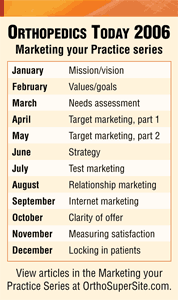Ask patients, referrers for feedback on how satisfied they are with your practice
Experts suggest surveying patients about clinical and non-clinical issues to find ways to improve.
![Marketing your Practice [logo]](../images/content/OT/commonart/marketinglogo.gif) Orthopedic practices interested in improving the quality of care and other services they provide must take steps to measure customer satisfaction. This can usually be done through a simple, fairly immediate feedback loop, but it should be done often.
Orthopedic practices interested in improving the quality of care and other services they provide must take steps to measure customer satisfaction. This can usually be done through a simple, fairly immediate feedback loop, but it should be done often.
In the book Marketing an Orthopedic Practice, John B. Pinto, president, J. Pinto & Associates Inc., San Diego, wrote: “No monetary rewards are worth a patient’s getting unneeded or inadequate services — even once.”
Retailers have clearly gotten the message about the importance of tracking customer satisfaction.
After shopping at a “big box” retailer, how often has the cashier drawn your attention to a survey code at the bottom of your receipt and you later filled out the customer satisfaction survey online? This lets the retailer know exactly how things went in their store and gets specific feedback to management within days or hours of a purchase.
|
Most practices can benefit from measuring their customers’ satisfaction in a similar way, trying to answer the question: “How good of a job are we doing?”
Consistently tracking referral source and patient satisfaction is critical to a practice’s success.
Eric N. Berkowitz, PhD, suggested using a customer contact audit to qualitatively assess the satisfaction of patients or referrers.
“At each point of interaction, [you] need to measure two things: importance and expectations,” he said in a presentation to the American Academy of Orthopaedic Surgeons.
Quantitative approaches can also be useful. For example, when surgeons track their sources of patients they get a good indication of which referrers are happy dealing with the practice and who is not satisfied, marketing specialist Chris Ives, told Orthopedics Today.
The important next step: Follow up and quickly correct problems.
Patient satisfaction
Most practices find it easiest to measure patient satisfaction. A straightforward way to do that is to use a simple “satisfaction” survey patients can complete on paper in the office, return by mail, via the phone or complete on-line.
To ensure on-line surveys get used, at the end of each patient’s visit have a staff member ask the patient to complete the Internet survey and give them a slip of paper with the Web address on it.
 In his book, Pinto includes a sample patient questionnaire which covers such areas as scheduling time, office environment, staff courtesy, time spent waiting to see the doctor, level of care delivered and whether the patient had all of his/her questions answered.
In his book, Pinto includes a sample patient questionnaire which covers such areas as scheduling time, office environment, staff courtesy, time spent waiting to see the doctor, level of care delivered and whether the patient had all of his/her questions answered.
They should also include open-ended questions so patients can expound upon the good, and the bad.
“Patient satisfaction surveys should be available every time a patient comes in so they have a means to comment on the services,” said Ives, of Ives Services Inc., Greenwood, Colo.
Measure satisfaction simply
How the survey is administered is up to the practice. Ives told Orthopedics Today he recently helped the Steadman-Hawkins Clinic implement a patient satisfaction survey that is completed on-line.
Since Steadman-Hawkins clinicians traditionally spend a considerable amount of time with each patient, Ives said the practice has tracked patient outcomes, which include standard satisfaction measures, for years.
However, management chose the survey approach after they added another location and needed clear-cut, office-specific feedback.
Their new tool quickly gives them that information in a way that is quantifiable and organized by provider, he said. Measuring referrer satisfaction requires more savvy techniques.
Never send a survey to another physician; that could irritate them. Instead, consider holding informal meetings with primary care and other physicians to ask how you are doing with access, response times, etc.
Should a doctor identify any concerns, address them right away and later call back to let him or her know how you resolved the problem.
For more information:
- Berkowitz EN. Strategic positioning and marketing ICL#328. Presented at the American Academy of Orthopaedic Surgeons 72nd Annual Meeting. Feb. 23-27, 2005. Washington.
- Pinto JB. Marketing an orthopedic practice. TBI Press, Dallas. 1992. pintoinc.com.

![John B. Pinto [photo]](/~/media/images/news/print/orthopedics-today/2006/11_november/pinto_70_90_19150.jpg)